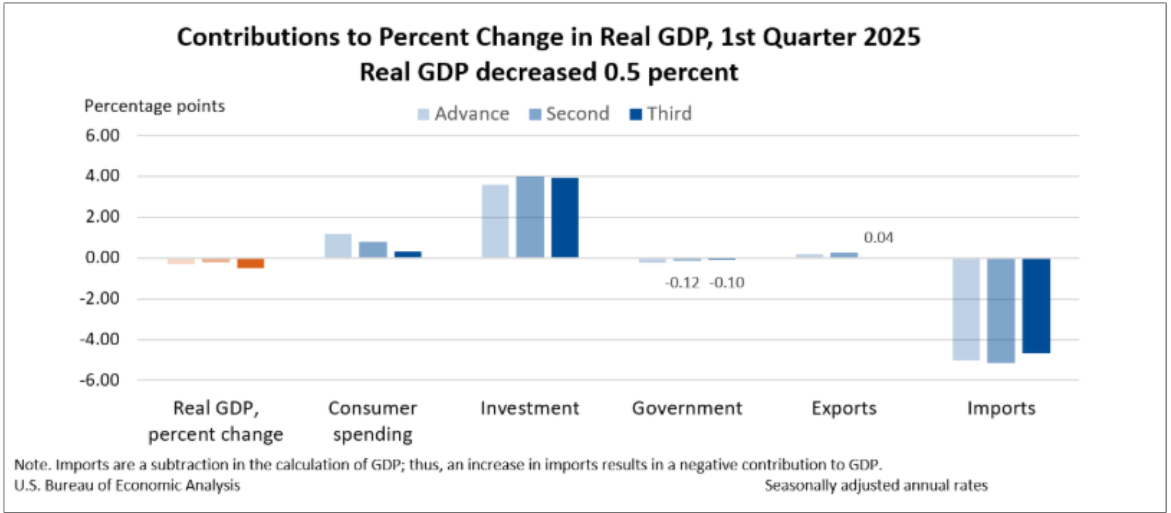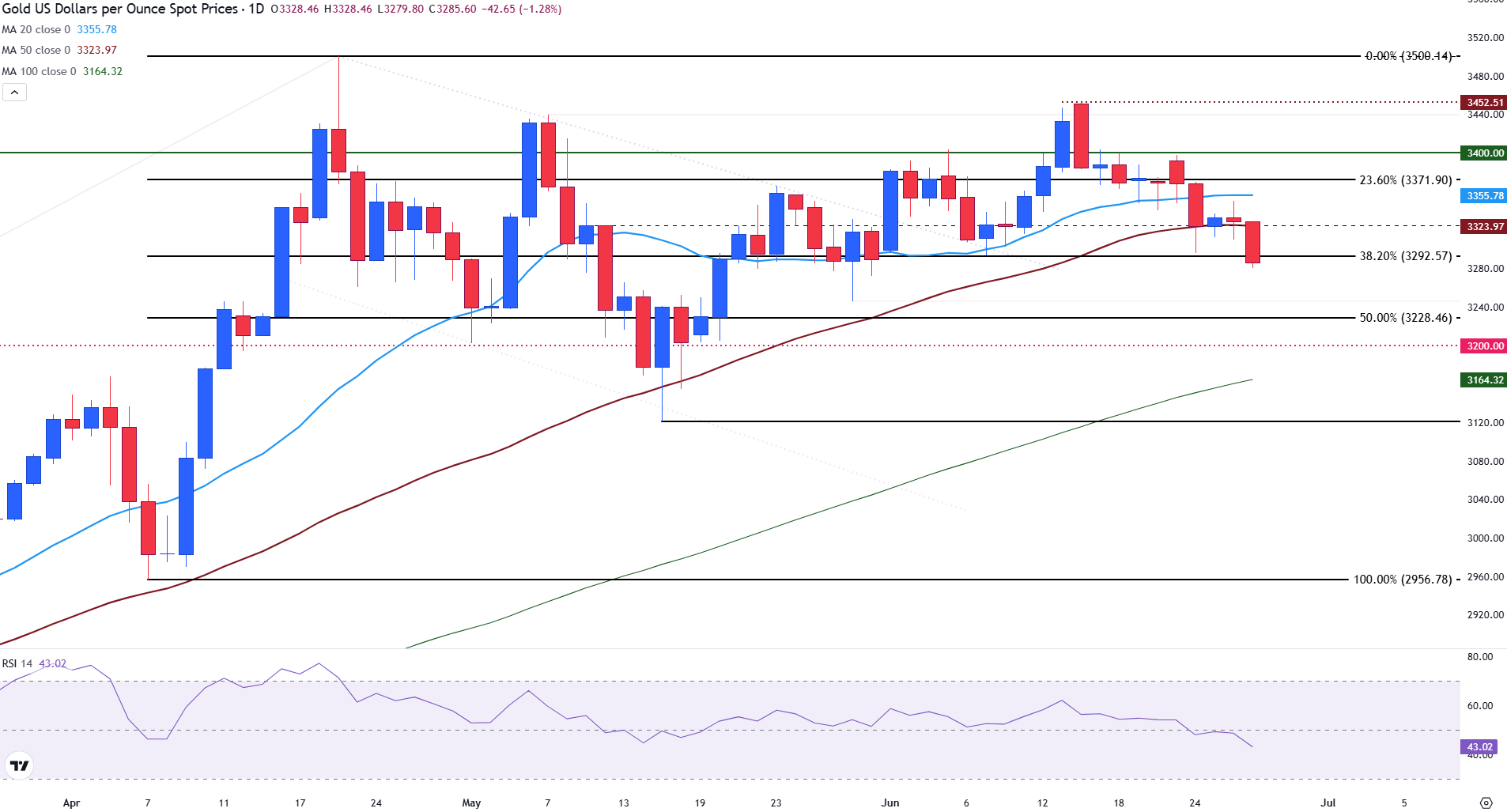Gold suffers another setback following a US-China trade truce, ahead of PCE inflation report
- Gold price plunges on optimism of a US-China trade deal.
- Safe-haven flows continue to decline ahead of the release of core PCE data and the Michigan Consumer Sentiment Index.
- XAU/USD falls below $3,300, with the RSI hinting at a deeper correction.
Gold (XAU/USD) is suffering another setback after reports telling that China and the United States have reached a trade deal.
As risk appetite continues to improve, the precious metal has been under pressure this week. With safe-haven flows shifting toward riskier assets, Gold is trading below $3,300 at the time of writing on Friday.
Core PCE data takes the spotlight
Friday’s US economic agenda, includings the release of the core Personal Consumption Expenditure (PCE), will be closely monitored. This important dataset measures the pace at which prices of goods and services are rising and is released on a monthly basis. It is the Federal Reserve’s preferred measure of inflation, which plays a significant role in setting expectations for interest rates.
Although the May print is expected to show a slight increase on an annual basis, major deviations from expectations and the repricing of information can have a direct impact on the Gold price.
Moreover, President Trump is putting immense pressure on the Fed to cut rates to stimulate the economy.
A major concern for the Fed has been the impact of tariffs on inflation. A trade deal with China, which has resulted in a pause of higher reciprocal tariffs on Chinese imports until August 12, could alleviate some of the pressure that potential higher tariffs may have on the US economy. According to the CME FedWatch Tool, the probability of a 25-basis point (bps) rate cut in September has increased to 72%, with markets anticipating rates to fall by at least 50 bps by year-end.
While lower rates bode well for Gold, the increase in demand for equities and riskier assets may continue to weigh on bullion in the short term.
Daily digest market movers: Gold awaits the release of key US economic data as safe-haven demand fades
- Analysts expect the PCE figures scheduled for 12:30 GMT to show that monthly core inflation (MoM) remains at 0.1% in May. On an annual basis, core PCE is estimated at 2.6%, slightly higher than the May 2024 reading of 2.5%
- At the same time, Personal Spending and Income numbers will be released. The consensus is that the May data will reflect a decline in both numbers.
- Thursday’s final Gross Domestic Product (GDP) reading for the first quarter showed that the US economy had contracted by 0.5%, as imports increased before the imposition of the higher tariff rates announced by Trump on “Liberation Day.”
- The table below illustrates the breakdown of the Q1 GDP components released by the US Bureau of Economic Analysis on Thursday.

- Since consumer spending accounts for a substantial portion of the US GDP, a significant decline could enhance the prospects of a July rate cut.
- At 14:00 GMT, the University of Michigan (UoM) will release the final Consumer Sentiment numbers for June, representing how individuals perceive the current economic conditions.
- Consumer Expectations, reflecting potential changes in prices over the next 12 months, will also be closely monitored. Along with the 1 and 5-year Inflation Expectations numbers for June, which are expected to come in at 5.1% and 4.1% respectively.
- The Bank Stress Test, published by the Federal Reserve's Board of Governors, will be released at 20:30 GMT. This report outlines how the largest U.S. banking institutions would perform under various adverse economic scenarios. It is designed to evaluate the resilience of the financial system; the test assesses how these banks would respond to severe financial shocks.
- The results can influence the Federal Reserve’s monetary policy outlook and help gauge potential risks to its long-term goals of price stability and sustainable economic growth.
- For Gold, the culmination of these data releases may play an important role in determining the direction of XAU/USD. Especially once the latest US-China progress on trade talks has been digested by markets, investors focus on the broader macroeconomic environment.
Gold technical analysis: XAU/USD extends losses as bearish momentum pushes the RSI below neutral territory
Gold remains under pressure, with prices trading below the key psychological level of $3,300, which now provides near-term resistance for the yellow metal.
Above that is the 50-day Simple Moving Average at $3,324 and the 20-day SMA near $3,356.
The Relative Strength Index (RSI) at 43 signals fading bullish momentum without yet entering oversold territory.
In the bearish scenario, a sustained break below the mid-point of the April low-high move, represented by the 50% Fibonacci retracement level, provides support at $3,228. A break of which could open the door toward the $3,200 psychological handle. The 100-day SMA at $3,164 acts as a deeper support level.

On the other hand, the bullish scenario would require a decisive recovery above the 20-day SMA, potentially reigniting upside momentum toward the $3,400 and $3,452 resistance levels. Until such a move materializes, Gold may remain vulnerable to deeper retracements within its broader consolidation pattern.
Economic Indicator
Core Personal Consumption Expenditures - Price Index (YoY)
The Core Personal Consumption Expenditures (PCE), released by the US Bureau of Economic Analysis on a monthly basis, measures the changes in the prices of goods and services purchased by consumers in the United States (US). The PCE Price Index is also the Federal Reserve’s (Fed) preferred gauge of inflation. The YoY reading compares the prices of goods in the reference month to the same month a year earlier. The core reading excludes the so-called more volatile food and energy components to give a more accurate measurement of price pressures." Generally, a high reading is bullish for the US Dollar (USD), while a low reading is bearish.
Read more.Next release: Fri Jun 27, 2025 12:30
Frequency: Monthly
Consensus: 2.6%
Previous: 2.5%
Source: US Bureau of Economic Analysis
After publishing the GDP report, the US Bureau of Economic Analysis releases the Personal Consumption Expenditures (PCE) Price Index data alongside the monthly changes in Personal Spending and Personal Income. FOMC policymakers use the annual Core PCE Price Index, which excludes volatile food and energy prices, as their primary gauge of inflation. A stronger-than-expected reading could help the USD outperform its rivals as it would hint at a possible hawkish shift in the Fed’s forward guidance and vice versa.

